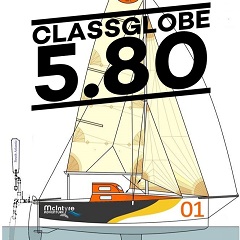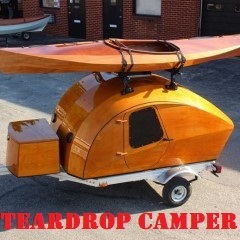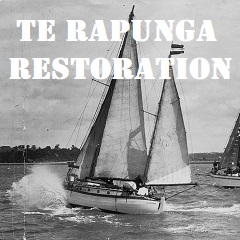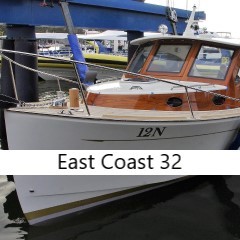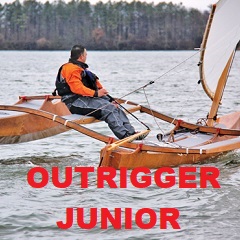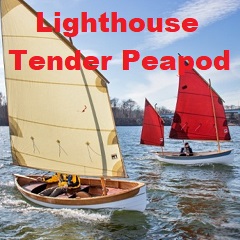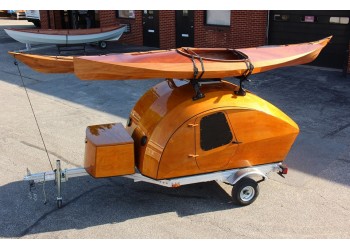Teardrop Camper
Availability: Made to Order (approx. 5 weeks)
Ex Tax: See options for price
A "teardrop" trailer is a small camper. The name comes from the streamlined shape, and the type dates back at least to the 1930's. As cars get smaller, storage space more expensive, and recreational time more precious, a new appreciation is growing for the efficiency of really good teardrop campers.
| Model | Length | Width | Height | Basic Shell Weight |
|---|---|---|---|---|
| Teardrop Camper | 2.44m | 1.67m | 1.14m | Approx. 85kg |
See here for dimensions
Suggested tools and consumables (kit builders)
Sample bill of materials (plans builders)
A fan of small boats, small cars, and small houses, designer John C. Harris found the concept of a teardrop camper irresistible. "Think of it as a big step up from a tent in terms of comfort and utility. But it's so compact and light that I could tow it behind my Mini Cooper. Even the smallest 'traditional' RV trailers are going to require at least a mid-sized tow vehicle, and will make a giant dent in your gas mileage."
Teardrops have always been available as build-your-own projects. You can find ads for kits and plans in old magazines from the 1930's and 40's. Some of these are pretty sophisticated, but most are clumsily-built, and look and feel cheap. "What if we take the same boatbuilding materials and techniques we've been refining for 25 years at Chesapeake Light Craft and build a teardrop trailer? And the same sculptural approach that we bring to boat design?" Harris asks.
The result is the 5' x 8' (1.5 x 2.4m) teardrop you see here, and it's a lot more elegant than the common "canned ham" teardrop designs. Drawn around a 60 x 80" (1.5 x 2m) air mattress, this little camper is small on the outside but surprisingly roomy on the inside. Two adults up to 6'6" (198cm) can stretch out in great luxury. Large doors on both sides and a 15" square hatch on the roof provide easy access and copious ventilation. There's room for a 12-volt electrical system to run lights, fans, a stereo, and charging plugs for devices.
A large galley occupies the locker in the rear of the trailer. While this space could be customized in many different ways, staff designer Dillon Majoros has devised a brilliant shelving unit that drops in as a separate module, and which we'll offer as a kit option. For car-camping or tailgating, this will be a giant improvement over a tent. No fooling around setting up a tent: arrive at destination. Park. Open door. Climb in. Go to sleep. Please note, due to availability issues Australian Galley Module kits include a standard gaboon plywoood face rather than Sapele veneered face.
While a trailer won't be included in the kit package, one of the key features of the design is that it can fitted on nearly any trailer. "The architecture lends itself to fitting on just about anything with wheels. Boat trailers, flatbeds, whatever. Just bolt it down and go." -John Harris
Construction of the CLC Teardrop will be familiar to anyone who's built a stitch-and-glue kayak or small boat. Starting from a kit, computer-cut marine plywood panels are bent into a simple mold (included with the kit). The seams are reinforced with epoxy and fiberglass tape. The teardrop is flipped over, the mold removed, and the streamlined, sculptural shell is sheathed on the exterior with a tough coating of fiberglass for strength and durability. Doors and hatches are cut on marks engraved by the computer cutter. Then lots of sanding, install the galley, and you're done. While a trailer won't be included in the kit package, one of the key features of the design is that it can fitted on nearly any trailer.
The roof has been reinforced from the start for roof-racks, so you can carry kayaks or bicycles atop the CLC Teardrop. An optional lockable storage box, sized to fit a 48-quart cooler, mounts forward of the camper on the trailer tongue.
In June 2017 students gathered at Chesapeake Light Craft's boatbuilding classroom in Annapolis to assemble their own CLC Teardrop Camper. They started from kits on Monday and rolled the campers out 13 days later, ready for sanding, finishing, and outfitting at home.
Using three GoPro cameras, Chesapeake Light Craft captured a time-lapse of the entire Build-Your-Own-Teardrop-Camper class in their Annapolis shop that can be viewed below or here?.
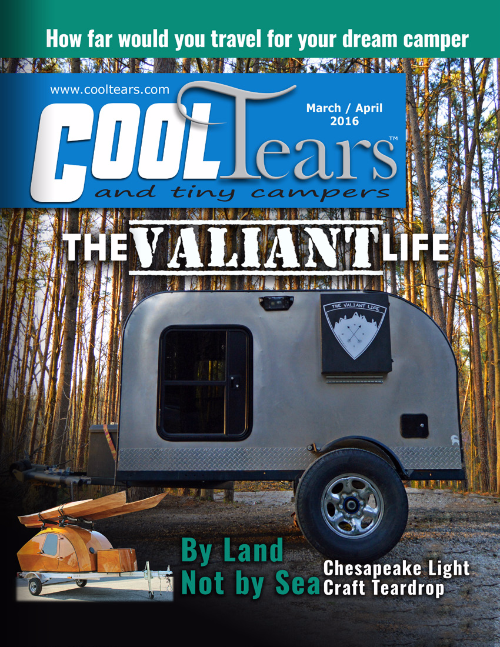 |
Integrated Cargo Carrier:
Introducing the Teardrop Camper Integrated Cargo Carrier. The ICC increases storage capacity to a cavernous 23 cubic feet (0.66m3) - comparable to a contemporary hatchback - while adding only 9" (23cm) of height to the complete package. The cargo volume is divided into five flexible storage compartments so you can organize and stow your gear as you see fit. It's an easy retrofit if you already have a Teardrop Camper, or you can build it alongside your Teardrop Camper project.
Two locking side doors flank the forward sides of the ICC, just under the doors of the Teardrop Camper, so you can access gear quickly when you're getting in or out. At the rear of the ICC are two sliding drawers, each with four removable dividers. Since they're right under the galley compartment of the camper, these are the obvious places to stow provisions and cooking supplies. Less obvious, perhaps, is the function of the open back to the drawers: Remove the dividers and the entire length of the side compartment can swallow oversized gear. Drop in a surfboard, guitar, folding table; you name it.
The centerline compartment runs the entire length of the ICC. It's accessible through a locking rear door nestled between the two sliding drawers. At nearly 85" (2160mm) long, it's a perfect place to stow a pop-up tent, skis and poles, oars, fishing rods, tripods, or anything else long and skinny.
An ultralight folding step-stool nests atop the drawer dividers in either of the side drawers. Deploy the step if you need a touch more height to access the galley, or use it as an ottoman while you're hanging around the campfire.
The ICC features the same rugged marine plywood, epoxy, and fiberglass construction as the CLC Teardrop, and it's waterproof at 70mph (110kph) in a rainstorm on the highway.
The ICC is much more than "just a box". It fits harmoniously with the proportions of the Teardrop Camper: you'll only know it's a separate unit because you built it! And in the same way the Teardrop appears so much more voluminous on the inside than out, you'll be amazed by the quantity of gear you can organize and stow - in lockable compartments - for your next adventure.
Frequently Asked Questions:
When will kits and plans be available in Australia?
What is construction like?
You can link to a high-res drawing, with dimensions in standard and metric units, here. The shell itself measures 96-1/4" long, 65-7/8" wide, and 44-7/8" tall. The actual height off the ground will vary a lot depending on your trailer choice, but expect between 62 and 68 inches.
What is included in a base kit?
- Parts CNC-machined from BS1088 marine plywood
- Slot-together CNC-cut female mold
- Fiberglass
- Epoxy kit
- Copper wire for stitching and various fasteners
- Marine acrylic windows
- Door and galley hatch hinges
- Gasket material for doors and galley hatch
- Hatch lift pistons and hardware
- Door and galley hatch latch assemblies
- Bezel for roof hatch
- Standard fit-kit for trailers
- Spiral-bound illustrated step-by-step shop manual
- Parts CNC-machined from BS1088 marine plywood
- Slot-together CNC-cut female mold
- Door and galley hatch hinges
- Bezel for roof hatch
- Standard fit-kit for trailers
- Spiral-bound illustrated step-by-step shop manual
What is not included in the kits?
- Trailer
- Top Coat, e.g. Varnish, Paint, etc.
- Tools
- Consumables e.g. sandpaper, brushes, rollers, etc.
- See here for further details regarding required tools and consumables.
What if I want to build from scratch? What are the plans like?
Plans comprise full-sized patterns for every part in the Teardrop Camper. Spread the patterns out on your plywood sheets, transfer the shapes, and cut them out with a sabersaw. The plans package includes patterns and instructions for options such as the galley module and the storage box.
Can I download the plans?
Not yet. We might develop a downloadable version of the plans in the future, but for now we'll be mailing tubes with full-sized patterns.
I have access to a CNC machine. Can you send me the CAD files for the CLC Teardrop Camper?
Not until digital-rights management for architectural work catches up to books and music. Yes, we wish it was that easy, too! But in a world swarming with intellectual property thieves, the technology simply isn't ready.
How will the Teardrop Camper be shipped?
Due to the Teardrop Campers bulk in kit form, and in order to protect the pieces in transit, all components have been left tabbed into larger sheets of plywood in order to protect the pieces, simply punch out the pieces with a chisel or jigsaw and dispose of the unnecessary plywood. You will receive a strapped and protected pack of plywood that weighs around 200kg, please ensure you have somewhere clear for its delivery before unpacking it (2500x1220x150mm).
When it comes to sourcing a suitable trailer in Australia for the Teardrop Camper, you have a few options; you can either approach a local trailer maker for a custom trailer, or have a look around for a pre-built trailer that suits the dimensions of the Teardrop Camper. This can be as simple or as complicated as you would like with the Teardrop Camper even capable of being fitted (with some modification) on top of a standard 8x4 box trailer. Please note; while it is possible to mount it to a box trailer, this will potentially raise the camper substantially, making it difficult to access the doors and galley from the ground, but will offer additional storage space underneath the camper in the trailer itself.
Another option is something like the Carlex 958TC 8x5 Multi-Trailer (UNFORTUNATLEY NO LONGER AVAILABLE) which looks to be a good fit for the Teardrop Camper. Please note, Denman Marine has not installed a camper on a Carlex trailer, this simply looks like a good fit based on both the Teardrop Camper dimensions, trailer modifications may be required. See below for a Teardrop Camper, built by Tim in Victoria, mounted on a slightly shortened Carlex 958TC trailer.
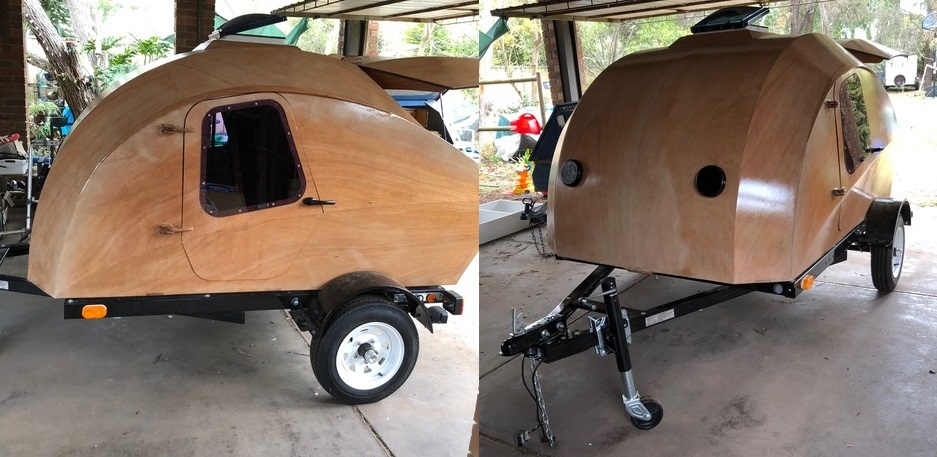
Please keep an eye on updates from CLC.
As the Teardrop Camper is a new kit from CLC, it is still subject to frequent updates as various customers find inconsistencies in their kit/manual etc. If you have any problems please consult the CLC Teardrop Camper forum first, in particular the technical bulletins to see if there has been anything posted regarding your problem (http://teardropforum.com/category/technical-bulletins-camper-updates/). Otherwise, please don’t hesitate to contact us at Denman Marine to assist with your problem.
Plans and manual package:
This package is for builders who want to start from scratch and cut out their own parts. (You do not need to purchase this option if you are building from a kit.)
For an indication of what you will need, see the bill of materials.
The Teardrop Camper "Plans & Manual" option includes full-sized patterns for every part in the camper and the spiral bound assembly manual, lavishly illustrated with more than 1,000 drawings and B&W photos. There's also a 40-page Plans Builders Supplement to guide you through the additional steps of building the Teardrop Camper from scratch. Materials lists and tool lists are included.
Patterns and instructions are included in this package for the optional galley module and storage box.
Plans and instructions are in both metric and imperial measurements.

Patterns comprise six large sheets, over 100 lineal feet (30m) in total, laser-printed for minimal distortion and shipped in a roll.
The level of detail is several orders of magnitude greater than what you can expect from an old magazine article and plans of that caliber.
There are various ways to transfer the patterns to the plywood. We recommend using an awl or an ice pick to indent the plywood:
Then simply connect-the-dots freehand:
Use a small circular saw and/or a saber saw to cut out the parts.
For smaller parts, the full-sized patterns may be glued to the plywood, and cut on a bandsaw.

